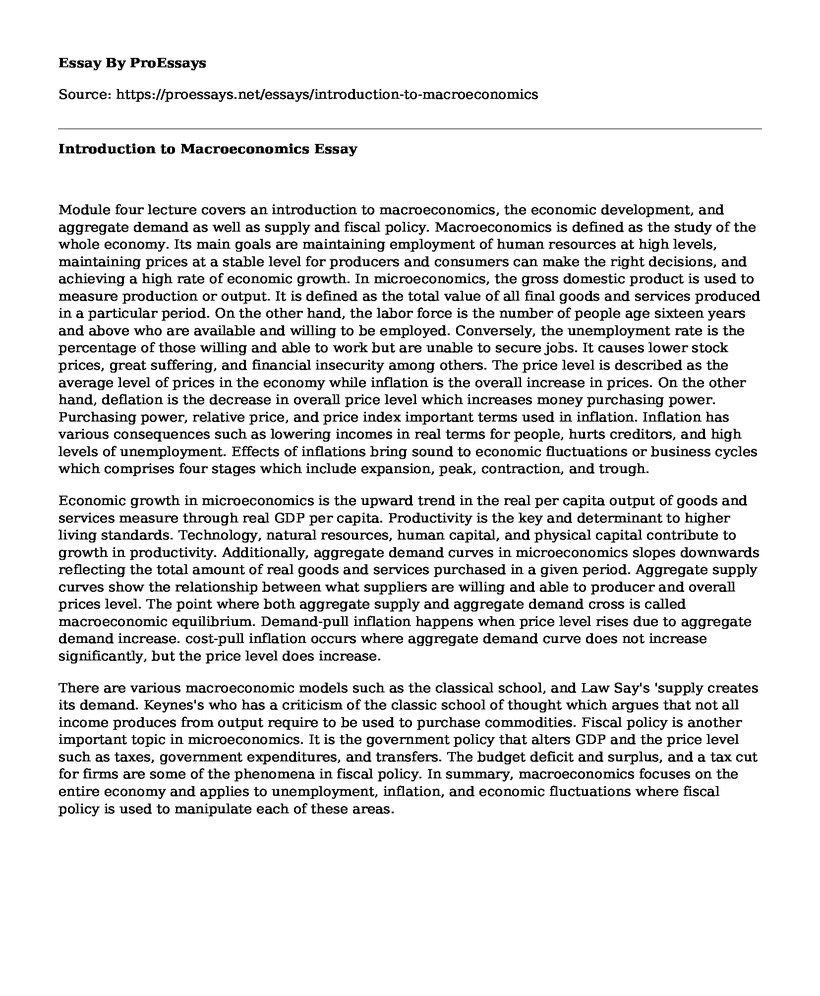Module four lecture covers an introduction to macroeconomics, the economic development, and aggregate demand as well as supply and fiscal policy. Macroeconomics is defined as the study of the whole economy. Its main goals are maintaining employment of human resources at high levels, maintaining prices at a stable level for producers and consumers can make the right decisions, and achieving a high rate of economic growth. In microeconomics, the gross domestic product is used to measure production or output. It is defined as the total value of all final goods and services produced in a particular period. On the other hand, the labor force is the number of people age sixteen years and above who are available and willing to be employed. Conversely, the unemployment rate is the percentage of those willing and able to work but are unable to secure jobs. It causes lower stock prices, great suffering, and financial insecurity among others. The price level is described as the average level of prices in the economy while inflation is the overall increase in prices. On the other hand, deflation is the decrease in overall price level which increases money purchasing power. Purchasing power, relative price, and price index important terms used in inflation. Inflation has various consequences such as lowering incomes in real terms for people, hurts creditors, and high levels of unemployment. Effects of inflations bring sound to economic fluctuations or business cycles which comprises four stages which include expansion, peak, contraction, and trough.
Economic growth in microeconomics is the upward trend in the real per capita output of goods and services measure through real GDP per capita. Productivity is the key and determinant to higher living standards. Technology, natural resources, human capital, and physical capital contribute to growth in productivity. Additionally, aggregate demand curves in microeconomics slopes downwards reflecting the total amount of real goods and services purchased in a given period. Aggregate supply curves show the relationship between what suppliers are willing and able to producer and overall prices level. The point where both aggregate supply and aggregate demand cross is called macroeconomic equilibrium. Demand-pull inflation happens when price level rises due to aggregate demand increase. cost-pull inflation occurs where aggregate demand curve does not increase significantly, but the price level does increase.
There are various macroeconomic models such as the classical school, and Law Say's 'supply creates its demand. Keynes's who has a criticism of the classic school of thought which argues that not all income produces from output require to be used to purchase commodities. Fiscal policy is another important topic in microeconomics. It is the government policy that alters GDP and the price level such as taxes, government expenditures, and transfers. The budget deficit and surplus, and a tax cut for firms are some of the phenomena in fiscal policy. In summary, macroeconomics focuses on the entire economy and applies to unemployment, inflation, and economic fluctuations where fiscal policy is used to manipulate each of these areas.
Cite this page
Introduction to Macroeconomics. (2022, Mar 15). Retrieved from https://proessays.net/essays/introduction-to-macroeconomics
If you are the original author of this essay and no longer wish to have it published on the ProEssays website, please click below to request its removal:
- Total Rewards Program: Combining Financial & Non-Financial Benefits for Employees - Essay Sample
- Essay Sample on McDonald's Failures: Globalization, National Image, Taste & Marketing
- Growth, Decline, and Globalization: Is the World Growing Together or Apart? - Essay Sample
- Oman: International HRM for the 21st Century - Essay Sample
- Business Process Automation: Understanding Trends & Tools for Growth
- Similarities and Differences Between Financial Systems - Paper Example
- Paper Example: HR Development Plan at Titanic Gym Equipment: Nurturing Employee Growth







